Introduction
The use of taxis and private car hire services has been gaining prominence in the United Kingdom (UK). The services have been enabling individuals to commute easily to various destinations. This is evident since the services play a crucial role in the nation’s local transportation system by providing quality services to visitors and local residence. However, there has been an increasing need for the development of viable guidelines to streamline operations in the sector. This is critical in ensuring that the taxi and car hire firms operate under minimum quality standards. The idea is to facilitate safety and sanity in the sector that shows a promising future.
It is also to ensure that consumers receive quality, timely and reliable services at their request. Consequently, the standards are to guarantee automation of car hire services to ease hiring and payment methodologies. This is a convenient way of conducting business since the world is gradually turning to e-transportation. This explains the significance of app technology. The system holds the capacity of boosting the process of user booking and payment through internet and phone services. It also holds the capacity of enhancing user safety and timely delivery of services.
Objectives of the report
The report seeks to satisfy the following objectives
- To facilitate the customization of taxi booking mobile app system that can fit user’s needs promptly.
- To relay basic strategies and technological support systems that are crucial in enhancing booking and payment services in the transportation sector.
- To report quality ideals that can facilitate effective management of taxis and private car hire services.
Background information
Over the years, UK has been striving to modernize its transport system. This compelled authorities in the nation to embark on high powered deliberations with an aim of streamlining operations in the sector. The leaders have developed viable policies that have started to yield fruits in the sector that is very significant for development. The initiatives have been facilitating the adoption of conventional transportation techniques, booking systems and maintenance approaches (Behrendt 69). Indeed, key stakeholders in the taxi and private car hire sector are crediting the initiatives for the growth in the industry.
They affirm that the initiatives have made it possible for taxi customers who find it hard to remember the details of their previous service providers to find them easily. This is a key reason why the advent of apps technology in the sector is critical. Its role is to mitigate the communication gap between taxi service providers and customers who should receive the best services without straining. Evidently, lack of proper operating guidelines of taxi services threatened to impede success in the sector. However, the current initiatives seek to turn around the sector’s operating guidelines (Behrendt 69). This will spur social and economic integration that is essential for development.
Problem statement
Indeed, there has been lack of holistic adoption of modern techniques of operations in the management of taxi services in UK. This has been compromising quality and timely service delivery in the sector. Poor adoption or integration of IT systems has been impeding booking processes, identification of free drivers and linkages to quality service providers. It has also been limiting provision of real time services since it compromises communication between stakeholders (Behrendt 69). This is evident since inferior systems limit coordination on key aspects that appertains to departure or arrival time that leads to wastage of time. Therefore, the report seeks to revolutionize operations in ailing sector by equipping stakeholders with credible information on essential application systems that they should install.
Purpose of design
The purpose for designing mobile app application software is to enhance the availability of taxi services (Behrendt 69). In particular, mobile app application system will make taxi services more available by providing essential communication incentives. This will facilitate timely service delivery and identification of key service providers by customers. The app systems will also transform the booking process by making it more efficient (Harindranath 1). Its use will benefit the stakeholders whereby taxi drivers are to achieve high returns due to high number of daily bookings. Consequently, the system will eradicate the apparent complications that customers face when they seek for taxi services.
Data gathering and analysis
The researcher adopted the use of questionnaires and interviews as key data gathering techniques. The techniques were used to acquire information from a sample size of 18 respondents who were picked based on their appropriateness in delivering quality response. The interviews and filling of questionnaires was done within a strict timeline of three weeks after which analysis was conducted. Five of the respondents were interviewed while thirteen were served with questionnaires. Literature reviews such as books, newspapers and transport journals were also used to aid data gathering process. This was to acquire exhaustive understanding of the customer’s expectations in transport industry.
Data analysis
Data analysis is essential in any research study because it leads to the formulation of reliable findings. The study adopted an effective data analysis method where experimental test technique was used. The technique facilitated in-depth analysis of the information gathered. This boosted the formulation of accurate findings that make the report reliable.
Findings
From the responses, it is clear that most individuals hire taxis through telephoning as opposed to hailing for the services on the streets. This was evident from the overwhelming response on this question. The respondents gave credible answers and insightful information pertaining to the use of taxi and the need for the transformation of operations in the sector. Their concerns were revolving on booking procedures and management of time especially the arrival and departure time. The respondent’s data as analyzed are presented below
Diagram 1: Are you a taxi/a car hire user or a driver
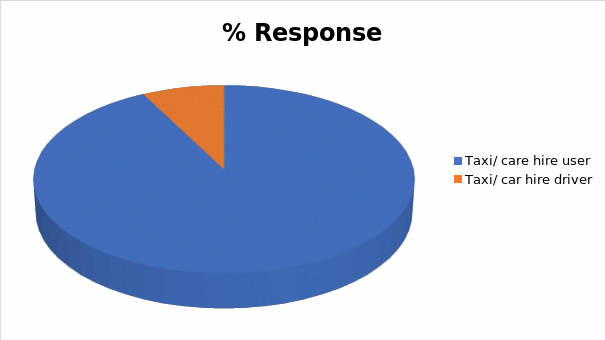
In response to question one that sought to establish whether the respondents were taxi users or drivers. 92.3% of the respondents stated that they are renowned taxi users who have interest in quality services. 7.7% of the respondents were drivers who are keen to ensuring effective service delivery. This shows that the information that was obtained hold immense credibility in ensuring that proper improvement steps are undertaken in the sector.
Table 1: Which car do you use or hire
In response to question two as shown in the table, most respondents affirmed that they prefer ordinary cars without other specifications. This was represented by 84.6%. While 15.4% preferred wheel chair accessible cars.
Diagram 2: How do you hire taxi
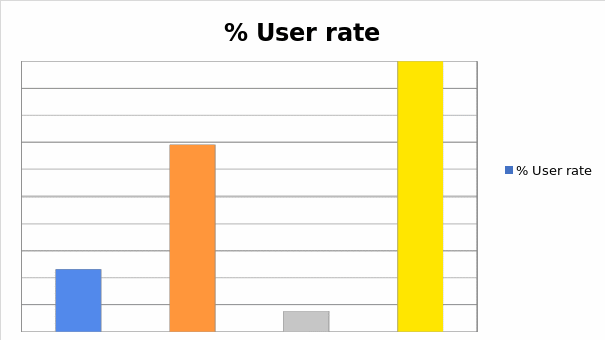
As noted, 69.2% of the respondents stated that they use telephoning when hiring taxis. However, 23.1% said that they apply hailing on streets when hiring taxis and 7.7% use online booking. This shows that online booking that authorities seek to advance has not been receiving full utilization. This can be attributable to lack of effective app systems and poor internet connectivity. This calls for speedy integration of the systems and development of viable operating guidelines.
Diagram 3: Have you been experiencing difficulties in booking
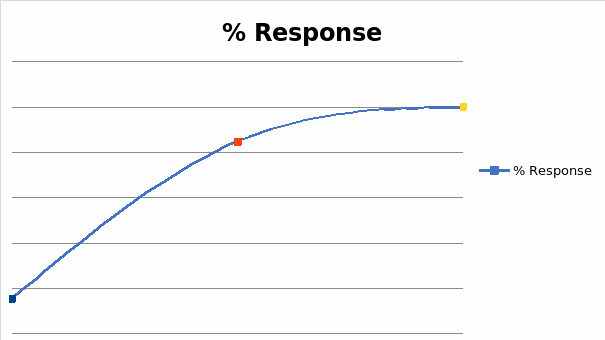
From the chart, 84.6% of the respondents who use respective taxi booking methods reports that they have not been experiencing serious difficulties. However, 15.4% of the respondents have been experiencing difficulties in the booking processes. This shows that a good number of taxi users are trying to cope with the booking systems that are available since they lack other effective options. Among those who report difficulties, their concerns relates to time wastage, unfair charges, safety and fear of not getting repeat quality services.
Table 2: Do you have a car to drive you where you want to go
Indeed, the majority of individuals who use taxi services are those who have cars. They only use the services due to various reasons that appertain to security, emergency and cost convenience. 84.6% of the respondents stated that they own cars while 15.4% does not own cars. This shows that nearly all taxi customers are individuals who own cars and who hold the capacity to pay for the services. They affirm that they would like to see a complete revolution of the sector.
Diagram 4: How often do you use a taxi
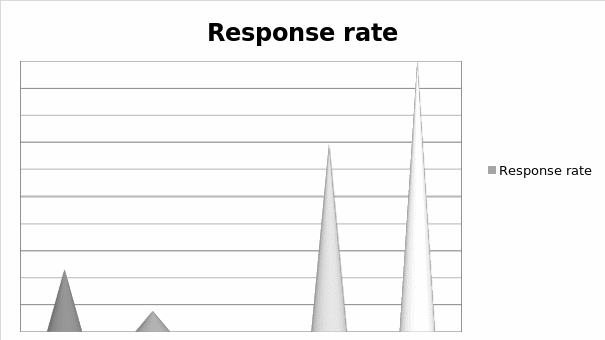
From the findings, 69..2% of the respondents stated that they use taxis occasionally while 23.1% and 7.7% reported daily and weekly use of taxis respectively. The figures show that most individuals use taxis occasionally and that their need for taxis may not be pre-planned. This justifies the need for the integration of effective booking system that provides real time services.
Diagram 5: What are the disadvantages of booking
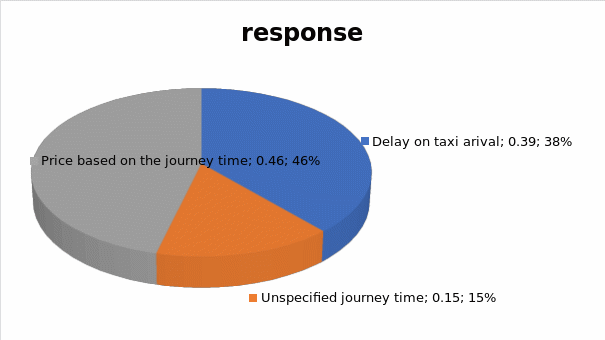
As shown in the chart, the respondents reported diverse complications that booking services present. In particular, 38.5% stated that booking results to delay on taxi arrival. This is because some of the taxi drivers may forget about the specified time or get other commitments. 15.4% stated unspecified journey time while 46.2% reported price issue. This shows that as much as online booking or use of app systems would be effective, it also has some limitations. The limitations must be addressed appropriately to enable full realization of the concept’s benefits.
Diagram 5: Do you use smart phones
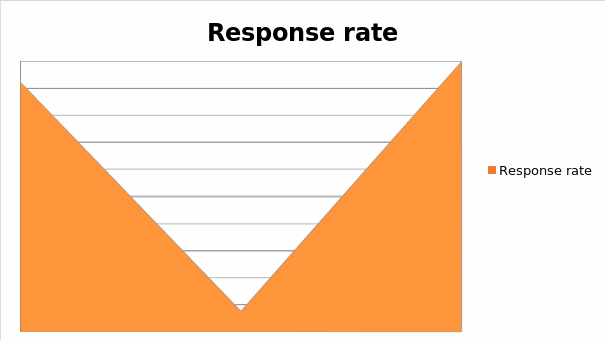
From the diagram, 92.3% of the respondents affirmed that they are using smart phones while only 7.7% stated otherwise. This would steer the integration of app systems on taxi driver’s phones to ease communication with them. It is an opportunity that seeks to enhance booking and payment for the taxi services.
Survey
The researcher conducted online survey to get credible information on taxi booking around the world. The survey was conducted to allow effective stakeholder participation. The successful process yielded credible and reliable results that have been instrumental in the development of modern booking system. Key questions that the respondents had to answer were.
- What mode of taxi hiring do you use?
- How often do you use a taxi?
- Do you prefer the use of a taxi to personal car?
- Do you prefer the use of smart phones for booking?
- Ro you think the integration of app system will enhance service delivery in the sector.
Most online respondents supported the idea of app system integration on phones. They stated that this is the best way to ensure improvement in communication and booking for taxi services. The respondents also preferred the use of smart phones or internet enabled systems for hiring taxi services with 85% of the respondents supporting the idea.
They stated that the introduction of smart phones offer individuals the best and convenient platform that aid access to internet services. This enables them to perform various tasks at their comfort zones with minimal movement. Therefore, the system would enable them make direct and real time taxi bookings (Harindranath 2). On the question pertaining to their preference for the use of a taxi in comparison to personal cars, 69% responded positively. However, they stated that they would actualize this effectively if ticketing, booking and payment procedures were not cumbersome. Generally, the survey depicts that, locals in UK are in need of superior taxi services. They seek for quality booking systems, management of time, fair pricing and effective communication.
Customer’s Interviews
The researcher conducted five interviews with random visitors in UK by speaking to them. The respondents were given the opportunity to respond to various questions that sought to establish their views on the quality of taxi services in UK. The use of this technique was significant since it enabled the acquisition of basic information that one cannot obtain using other techniques of data collection. The interview findings indicated that, most visitors prefer the use of taxis as they move to various destinations.
They also supported the use of mobile enable programs for booking and identification of quality service providers. They affirmed that this is an excellent initiative since it will facilitate pre-order bookings that have been lacking (Harindranath 39). They also affirmed that this would avert the complications they have been facing in terms of delays on taxi arrival time. Further, they also stated that, the cost of acquiring taxi services in UK is very high and the traffic based charging system should be reviewed.
Case studies
The researcher conducted two case studies in Huddersfeild University and Kingsgate mall. The aim of conducting the case studies was to establish and collect empirical evidence on taxi management issues such as waiting time. For each case study, two components that include rank observation and driver waiting time were adopted. They were used to asses the level of passenger and driver waiting times effectively.
Summary of the case studies
As indicated, the taxi market can be segmented into two parts for purposes of quality service delivery and efficiency. The parts that include traffic and pre-booking hold the capacity to addressing the evident complications that compromise effective service delivery in the sector. They will ensure that both local and visitors who seek for taxi services are treated with immense decorum.
That is the incentives would enable them receive quality booking services, effective time management and payment systems. In particular, pre-booking part will enable visitors to make prior online bookings for taxi services before their arrival. This will reduce the waiting times that exposes both parties in the business to immense loses. Indeed, the modern technology is bound to advance taxi ticketing and present immense impact in the sector in terms of competition.
Analysis of taxi booking app
From the data obtained, long waiting times is a factor that hinders both local and visitors from ordering taxi services by phone or app systems. They instead prefer taking the available taxi in front of them. This calls for effective sensitization on the imperativeness of app system among its potential users (Harindranath 39). The sensitization process is to enable customers to build trust on the app system. This is by understanding that its use will help in ensuring timely response by taxi drivers. Taxi users should also understand that the system would enhance their capacity to achieving quality services since it is user friendly. Consequently, the system is vital since it provide viable mechanisms for cash and credit monetary transfer.
Study design
To capture the user’s needs effectively, the following recommendations should be under consideration while generating the design. The recommendations include the interface, hardware requirements, sample screens and performance evaluation (Harindranath 42). Firstly, the interface design should be user friendly. It should be very simple to use and should have few operating options or buttons to choose from that may be confusing. Secondly, the app hardware should be compatible to all types of smart phones such as OS platforms.
Sample Screens
Taxi on click
The user-friendly system will enable users to see the screen after opening the app application that corresponds to the paper prototype screen. The user is to be placed in the order area by default as he switches the selected tab, located in the left hand side. The user will enter his order details that include name, telephone number, pickup time and the mode of payment. He will then make an order for a taxi or pre-order if he intends to use late services. The system enables taxi users to choose their preferred service providers and call them directly using a call button. This explains how the system is to work and how it intends to eliminate the evident complications that have been impeding quality service delivery in the sector.
Performance evaluation and observation
The performance evaluation was conducted to ascertain the level of efficiency of the app system. The researcher used paper model prototype with different types of people, visitors and students. He also used two different scenarios for effective comparison. Under scenario one, it was assumed that a visitor was planning to visit UK the following week and he needed to book a taxi to ease his journey to the hotel. He had a special need and requested that the vehicle should be able to carry a disabled person. He also disclosed that he was to use a credit card in making payments. He then requested for a pre-book using the app system.
Scenario 2 depicts a student from a local university who wanted to go to Simsbury market. However, he did not have any special requirement on his order. In review of the scenarios, they all qualified for execution through the app prototype system. This is because the prototype provides basic programs that aid the execution of such orders. Both users found out that app system is an effective and efficient mode of booking.
Conclusion
Indeed, the app system has been designed with the requisite incentives to meet the user’s requirements. It has simple and easy to use applications that make it user friendly. The prototype application seeks to enhance taxi booking and payment system in UK. It also seeks to facilitate a complete transformation in the management of taxi services. That is it will ensure real time booking, arrival and departure durations. This will help in reducing time wastage and disappointment that is caused by unwarranted delays.
Works Cited
Behrendt, Siegfried. Eco-service Development: Reinventing Supply and Demand in the European Union. Sheffield: Greenleaf, 2003. Print.
Harindranath, Garry. New Perspectives on Information Systems Development: Theory, Methods, and Practice. New York: Kluwer Academic/Plenum Pub, 2002. Print.